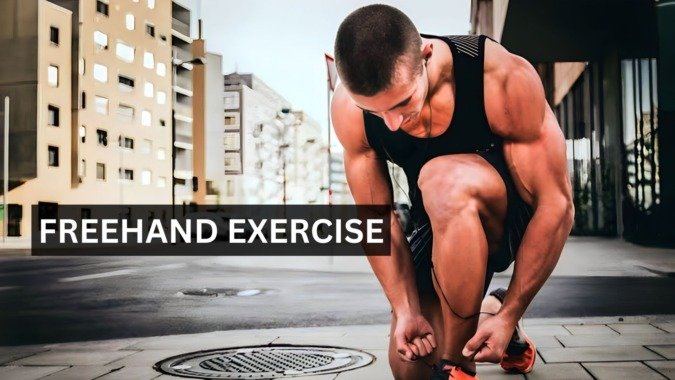

In the hectic world of today, staying physically healthy is essential for overall wellbeing. Freehand exercises, often known as bodyweight workouts, are a more straightforward and accessible alternative to the expensive equipment and gym visits that many people associate with exercise.
These exercises are a flexible and economical way to maintain good health and fitness because they make use of the body’s natural resistance and little to no equipment. This in-depth tutorial will cover a variety of bodyweight exercises, the advantages of freehand exercises, and advice on how to design a freehand exercise plan.
Benefits of Freehand Exercises:
Convenience: Freehand workouts provide you the freedom to work out whenever and wherever you want. Bodyweight exercises can be performed anywhere, including at home, at a park, or while on the go, without the need for specialized gear or a gym membership. Maintaining consistency in your fitness routine is made simpler by this convenience.
Cost-effectiveness: Purchasing exercise equipment or joining a gym might be pricey. All you need for freehand exercises is your body, along with a few simple accessories like a yoga mat or a stable bar for pull-ups. Everyone can participate in exercise activities without breaking the wallet thanks to this economical strategy.
Versatility: A large variety of freehand exercises are available that focus on different muscle groups and fitness objectives. Bodyweight exercises allow you to perform a variety of exercises to build a well-rounded regimen, from squats and lunges to push-ups for developing the upper body and squats for working the lower body.
Improved Functional Strength: Freehand workouts frequently feature compound motions that engage many muscle groups concurrently, in contrast to machine-based exercises that isolate certain muscle regions. This practical strength helps with daily tasks and can enhance athletic performance.
Enhance Body Awareness: Without the aid of any apparatus, freehand exercises force you to stabilize your body. Better balance and body awareness are encouraged, which can assist avoid accidents and enhance coordination in general.
Increased Flexibility: Flexibility is improved by the dynamic motions included in many freehand exercises. Bodyweight exercises can gradually increase your range of motion and flexibility if you do them frequently.
Reduced Risk of Injury: For beginners, heavy weights and complicated machines might increase the risk of damage. On the other hand, bodyweight exercises make advantage of the body’s natural movements, thereby lowering the risk of accidents and injuries.
Types of Freehand Exercises
Let’s explore some common and effective freehand exercises:
Push Ups: A traditional upper body workout that works the core, triceps, shoulders, and chest. Push-up variations like decline push-ups and diamond push-ups increase the workout’s intensity and variety.
Squats: A crucial lower body exercise that works the glutes, lower back, hamstrings, quadriceps, and calf muscles. To target specific muscle groups, squats can be performed in a variety of postures, including narrow, broad, and sumo squats.
Lunges: Effective for strengthening the glutes, hip flexors, hamstrings, and quads. Lunges with diverse variations, such as walking lunges, reverse lunges, and lateral lunges, can challenge your legs in many ways.
Burpees: A full-body exercise that incorporates aspects of coordination, strength, and cardio. Burpees are intense and effective exercises that improve cardiovascular fitness.
Mountain Climbers: A dynamic exercise that works the core, shoulders, and legs while also providing a cardiovascular workout.
Body Weight Dips: Using parallel bars or sturdy surfaces like the edge of a bench, targets on the triceps, chest, and shoulders.
Pull Ups/Chin Ups: A great upper body exercise that strengthens the shoulders, back, and biceps. You can perform bodyweight rows utilizing a suspension trainer or bar if you don’t have access to a pull-up bar.
Jumping Jacks: A simple but efficient cardiovascular workout that works the shoulders, legs, and heart.
High Knees: It’s excellent for warm-up and provides a cardio workout that works the core and hip flexors.
Creating an Effective Freehand Exercise Routine

Having learned the advantages and varieties of freehand exercises, it is essential to create a productive exercise regimen. Here are a few advices:
Warm Up: Always warm up before exercising to get your body ready. After engaging in light cardiovascular exercises like jumping jacks or brisk walking for 5 to 10 minutes, loosen up the muscles by performing dynamic stretches.
Choose A Variety: To guarantee a well-rounded workout, integrate workouts that target various muscle groups throughout your routine. This diversity keeps the workout interesting and minimizes overuse of certain muscles.
Progressive Overload: Continually push yourself to get better achievements. As you gain stronger and more at ease, up the amount of repetitions, sets, or try harder types of exercises.
Form And Techniques: During each exercise, pay attention to good form and technique. By maintaining proper posture, one can minimize their chance of injury and maximize their effectiveness.
Rest And Recovery: Between workouts, give your body enough time to relax and heal. Muscles require time to recover and strengthen.
Set Goals: Set fitness objectives that are doable and practical. You’ll be inspired to keep going and improve if you keep track of your progress.
Cool Down: Spend a few minutes on a cool-down program after your workout, which might involve static stretches to increase flexibility and lessen discomfort.
Conclusion
Freehand workouts offer a practical, economical, and adaptable way to maintain a healthy lifestyle. They provide a thorough approach to training with a variety of bodyweight exercises that target various muscle areas.
Include freehand exercises in your regimen whether you’re a novice or a seasoned fitness enthusiast to reap the rewards of increased strength, flexibility, and general wellbeing. To develop a freehand fitness regimen that is both sustainable and successful, keep in mind to approach your workouts with perfect form, progress slowly, and have fun with the range of exercises available.






👍🏼